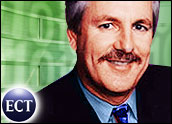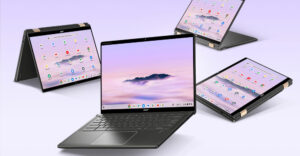
Last week I set the stage, indicating that Bill Gates and Steve Jobs would be taking shots at each other at the Consumer Electronics Show and Macworld, and that much of the drama would occur around the two shows.
It was a huge mismatch; even if you took Microsoft out of the mix, this was more like an ant against a dragon than even Jack against a giant, and — drum roll, please — the ant won.
By the end of Steve Jobs’ keynote, the media had lost interest in CES, and reporters focused like a laser on Apple’s earth-shattering announcements.
Let’s chat about how Steve stomped CES, and then we’ll chat a bit about what he did and didn’t announce, and close with some products exhibited at CES that are better than Apple’s current aging offerings.
Why Macworld Beat CES
Steve Jobs announced two products at Macworld: the iPhone and the Apple TV. He focused on what you could do with the products and spent virtually no time on the technology that made the products work.
In fact, one of the products, the iPhone, is something we often call “vapor” because it isn’t shipping for some months yet. Both products are hardware, and of the two, the iPhone is the most powerful — largely because it’s cool hardware.
Steve was passionate and excited. He sold the concepts, and by the time he was done, I doubt there was anyone in the audience who didn’t want the device — even though most probably had no idea how they would use it.
Bill Gates, the lead keynote speaker at CES, gave one of the most professional presentations I’ve ever seen him deliver. Nothing broke, he was on message, and he talked about Vista and talked about infrastructure, and he even talked about a new technology to sync iPod-like devices with your car.
He talked a lot. The cool hardware the OEMs (original equipment manufacturers) had worked for months to have ready was quickly streamed in a video, but neither demonstrated nor sold. The only hardware that got a lot of time on stage was the Xbox, which plays to a relatively small audience and wasn’t even new at last year’s CES. In short, it was kind of dull.
One huge embarrassment for Microsoft was that the best Vista application many of us saw was the new Yahoo Messenger for Vista. This product rocked, and it showcased more of the power of the product than much of what Microsoft demonstrated.
This is like Sony Vaio working better with the Xbox 360 than with the PS3; it becomes hard to fathom how a firm could simply not get its own offerings.
By staying focused, getting passionate about the product, and locking in on selling a few offerings rather than talking about a lot of stuff, Steve Jobs created value for his company that was immediately reflected in the stock market.
Bill Gates didn’t. In Bill’s defense — neither, apparently, did any of the other CES keynote speakers.
CES became this numbing mass of product announcements, and the most common comment I got from folks I spoke to was that there was nothing new at the show.
This was against the reality that there was a huge number of interesting things being announced, but they were all lost in the massive amount of noise coming out of CES, which made it nearly impossible see anything compelling.
One of the financial publications asked me why, given that consumer spending was up sharply, consumer electronics vendors were doing so poorly as a group financially.
My response pointed to these dynamics: that the CE vendors are unfocused, uncooperative with each other, and unable to drive interest in their products except by dropping prices.
If they could learn to do what Jobs apparently does regularly, then they would move their revenue lines in a positive direction faster — and their margins, for once, would follow.
What Apple Didn’t Announce
One of the reasons I no longer go to Apple events is that the selling is so good, it may take weeks before you figure out the important things the company didn’t say. If this was Macworld, where were the PCs? Where was Leopard? The products Apple released were actually more appropriate for CES than they were for what is a developer’s conference on the Mac.
This would be like Bill Gates talking exclusively about the Zune — a closed platform offering — at the PDC (Professional Developers Conference). The only thing the Macworld audience can do with the iPhone is buy it — it is a closed platform with no opportunity for developer support near term.
Typically, you have some new hardware; I was expecting at least one of the aging lines to be updated. Kind of makes you wonder if Apple is actually exiting the PC business or whether it is having significant execution problems someplace.
For Microsoft, because it releases road maps, you typically know when problems result. Because Apple does not, we typically aren’t aware of its slips. However, it does look like it is having difficulties both with Leopard and a PC hardware refresh, given that both are now overdue.
Considering what Apple didn’t cover, you have to wonder if the company is even serious about PCs anymore.
Apple Beating Products From CES
I didn’t see a better iPod than the current lines, but if such a product exists, I doubt we’ll see it before August — vendors in this class don’t like to give competitors much heads up. However, there was a lot of activity in other areas.
Better Than an Apple Monitor: In Europe, Dell monitors are most often bundled with Apple machines, because local laws require that monitors have height adjustments, and Apple Monitors don’t. Dell is taking this Apple connectivity thing seriously, and its new27-inch monitor is a piece of art. It has a black glass base, beautifully articulated arm, stainless steel finish, and a really good up-scalar — so you don’t need a high-end graphics card to drive it. This was the monitor to lust after; really nice work from a company that we typically don’t associate with this level of quality.
Better Than a MacBook: I mentioned the new ToshibaPortege R400 last week, and there was nothing close to it at the show in terms of technology, performance, battery life and Vista integration. This was the closest thing to a product built like an Apple product that I have ever seen, and it is at least a year ahead of anything else on the market. It even does wireless docking and has an external display.
Better Than an iMac: Also, as I mentioned last week, HP did the iMac right, with awide touch screen personal computer that offers a better weight distribution — less likely to get knocked off of a desk — and a community PC core benefit that could allow this PC to become a central part of any home. Coupled with the iLife-like features in Vista, this was the machine that Apple should have announced at Macworld. The innovative touch screen is what makes the difference. If you get a chance to see one, try out the screen; it is a natural for a future iMac.
Better Than the Mac Pro: Dell did a refresh of itsXPS 710 in jet — read iPod — black that was stunning not only with the covers on, but also with the covers off. The company actually did the automotive thing, where it finished the plenum for the BTX tunnel much like a Ferrari or Lamborghini does with its engines. It uses a unique water-cooled technology to push the performance envelope. This was so hot, someone actually broke in to the convention center and stole one from within a locked and secured glass case. This makes the current Mac Pro really look like it belongs with the geriatric set.
Newton: You have to see the newOQO computer, as most know this product group came out of Apple and designed the first Titanium notebook. The new OQO is stunning and has decent battery life. I carried one running Windows Vista in my jacket pocket for most of the show. It’s expensive — but, unlike the iPhone, it actually exists. It can draw a little crowd when you are using it — after the Apple announcement, a number of folks asked me whether it was the new iPhone.
Better Than Apple TV: Now, Apple clearly had one of these, and it looked good. However, I saw several that looked better. TheXbox 360 with IPTV — IPTV is Microsoft’s set top box platform that is sold by AT&T and Comcast — has capabilities similar to Apple’s offering, and it plays games, and it will provide flat-rate local programming.
This is what happens when Apple reannounces products like this. Cisco had a similar offering that didn’t play games, andDigio had an Internet TV version of its product that has consistently won Emmy awards for its user interface. None of these firms can outmarket Apple, but I think their offerings were stronger. I also think this is why Steve spent most of the time on the iPhone. The Apple TV product is good, but it isn’t complete — and other vendors actually have better offerings coming to market within a few months, and good high-definition content remains a problem for everyone in this segment.
Wrapping Up: Apple has made a gutsy move, and given the news surrounding Jobs of late, it needed one. Whether or not its products are successful, they are driving the CE market in many ways, and that should cause a number of CEOs to ask their staff why that is. These questions could help change an industry that is in desperate need of changing, and we should get better products more quickly, regardless.
Rob Enderle is a TechNewsWorld columnist and the Principal Analyst for the Enderle Group, a consultancy that focuses on personal technology products and trends.




















































